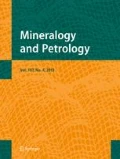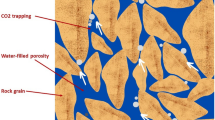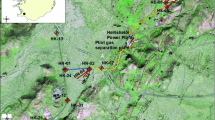Summary
In previous work,Gunter et al. (1993), suggested water-rock reactions in deep aquifers in sedimentary basins could sequester injected-CO2-waste from industry, thereby reducing greenhouse gas emissions. Experiments, carried out at 105°C and 90 bars CO2 pressure, to test the validity of this mineral-trapping of CO2 were unsuccessful due to sluggish kinetics of reaction. The most significant change recorded by the reaction products from these experiments was a large increase in alkalinity, which was attributed to very small amounts of water-mineral reaction. A computer model, PATHARC.94, was used to interpret this change in alkalinity and to predict the path and time necessary to reach equilibrium. Substantial trapping of CO2 by formation of siderite, calcite and aqueous bicarbonate ions was predicted to occur in 6 to 40 years.
Potential errors as high as two orders of magnitude were estimated based on a thorough examination of the kinetic data used in the modelling. In order to achieve reasonable time estimates, “reactive” surface areas were approximated by 100 micron spherical grains in the computer model. This represents a smaller cumulative surface area than actually present in the experiment. When these results are extrapolated to the field, where the aquifers are at lower temperatures,Perkins andGunter (1995a), concluded that CO2-trapping reactions are expected to take 100s of years to complete. This is sufficient time for the trapping to occur as the residence time of a packet of fluid in a deep low-permeability aquifer in a sedimentary basin is measured in 10,000s to 100,000s of years.
Zusammenfassung
In früheren Arbeiten habenGunter et al. (1993) Wasser-Gesteinsreaktionen in tiefen Aquiferen in Sedimentbecken vorgeschlagen, die injiziertes CO2 aus industriellen Abgasen aufnehmen, und damit die Treibhausgasemissionen reduzieren könnten. Experimente wurden bei 105°C und 90 bar CO2-Druck durchgeführt, um die Anwendbarkeit dieser mineralischen Fallen für CO2 zu testen; wegen der langsamen Reaktions-Kinetik waren diese nicht erfolgreich. Die markanteste Änderung, die diese Experimente in den Reaktionsprodukten hervorriefen, war eine beträchtliche Zunahme der Alkalinität, die auf geringfügige Wasser-Mineralreaktionen zurückgehen dürfte. Ein Computermodell, PATHARC 94, wurde benützt, um diese Änderungen der Alkalinität zu interpretieren und die erforderlichen Zeiten und Pfade vorherzusagen, die notwendig sind, um Gleichgewicht zu erreichen. Signifikanter Einbau von CO2 durch Bildung von Siderit, Calcit und Bikarbonat-tonen sollte dementsprechend in 6 bis 40 Jahren stattfinden.
Mögliche Fehler, die bis in zwei Größenordnungen gehen können, wurden aufgrund einer sorgfältigen Überprüfung der kinetischen Daten, die hier benützt wurden, ermittelt. Um sinnvolle Zeitmaßstäbe zu erreichen, wurden im Computermodell “reaktive” Ober flächen durch 100 Mikron große kugelförmige Körner repräsentiert. Dies stellt eine kleinere Gesamtoberfläche dar, als die, die tatsächlich im Experiment vorhanden ist. Wenn diese Ergebnisse ins Gelände extrapoliert werden, wo die Aquifere niedrigere Temperaturen aufweisen, kommenPerkins undGunter (1995a) zu dem Schluß, daß ein vollständiger Einbau von CO2 hunderte von Jahre benötigen würde. Diese Zeiträume sind ausreichend, da die Verweildauer einer Fluid-Menge in einem tief gelegenen Aquifer mit niedriger Permeabilität in einem sedimentären Becken in Größenordnungen von 10.000 bis 100.000 von Jahren gemessen wird.
Similar content being viewed by others
References
Anbeek C (1993) The effect of natural weathering on dissolution rates. Geochim Cosmochim Acta 57: 4963–4975
Acker JG, Bricker OP (1992) The influence of pH on biotite dissolution and alteration kinetics at low temperature. Geochim Cosmochim Acta 56: 3073–3092
Bachu S, Gunter WD, Perkins EH (1994) Aquifer disposal of CO2: hydrodynamic and mineral trapping. Energy Conversion and Management 35: 269–279
Busenburg E, Clemency CV (1976) The dissolution kinetics of feldspars at 25°C and 1 atm CO2 partial pressure. Geochim Cosmochim Acta 40: 41–49
Busenberg E, Plummer LN (1982) The kinetics of dissolution of dolomite in CO2-H2O systems at 1.5 to 65°C and 0 to 1 atm Pco2. Am J Sci 282: 45–78
Burton EA, Walter LM (1990) The role of pH in phosphate inhibition of calcite and aragonite precipitation in seawater. Geochim Cosmochim Acta 54: 797–808
Carroll-Webb SA, Walther JV (1988) A surface complex model for the pH-dependence of corundum and kaolinite dissolution rates. Geochim Cosmochim Acta 52: 2609–2623
Carroll SA, Walther JV (1990) Kaolinite dissolution at 25, 60 and 80°C. Am J Sci 290: 797–810
Chou L, Wollast R (1984) Study of the weathering of albite at room temperature and pressure with a fluidized bed reactor. Geochim Cosmochim Acta 48: 2205–2217
Chou L, Wollast R (1985) Steady-state kinetics and dissolution mechanisms of albite. Am J Sci 285: 963–993
Chou L, Garrels RM, Wollast R (1989) A comparitive study of the kinetics and mechanisms of dissolution of carbonate minerals. Chem Geol 78: 269–282
Fleer VN, Johnston RM (1986) A compilation of solubility and dissolution kinetics data on minerals in granitic and gabbroic systems. Atomic Energy of Canada Limited technical report TR-328-2, 170 pp
Gunter WD, Perkins EH, McCann TJ (1993) Aquifer disposal of CO2-rich gases: reaction design for added capacity. Energy Conversion and Management 34: 941–948
Gunter WD, Bachu S, Law DHS, Marawaha V, Drysdale DL, Macdonald DE, McCann TJ (1996) Technical and economic feasibility of CO2, disposal in aquifers within the Alberta Sedimentary Basin, Canada. Energy Conversion and Management 37: 1135–1142
Helgeson HC, Murphy WM, Aagaar P (1984) Thermodynamic and kinetic constraints on reaction rates among minerals and aqueous solutions. II. Rate constants, effective surface area, and the hydrolysis of feldspar. Geochim Cosmochim Acta 48: 2405–2432
Hitchon B (ed) (1996) Aquifer disposal of carbon dioxide: hydrodynamic and mineral trapping-proof of concept. Geoscience Publishing Ltd., Sherwood Park, Alberta, Canada, 161 p
Hitchon B, Gunter WD, Gentzis T (1996) The serendipitous association of sedimentary basins and greenhouse gases. Proceedings, American Chemical Society Symposium on “CO2, Capture, Utilization and Disposal”, Orlando, Florida, August 25–29, 5 p
Holdren GR, Berner RA (1979) Mechanism of feldspar weathering. I. Experimental studies. Geochim Cosmochim Acta 43: 1161–1171
Kharaka YK, Gunter WD, Aggarwal PK, Perkins EH, DeBraal JD (1988) SOLMINEQ.88: A computer program for geochemical modelling of water-rock interactions. U.S. Geological Survey, Water Resource Investigation Report: 88-4227
Knauss KG, Wollery TJ (1986) Dependence of albite dissolution kinetics on pH and time at 25/dgC and 70/dgC. Geochim Cosmochim Acta 50: 2481–2497
Knauss KG, Wollery TJ (1988) The dissolution kinetics of quartz as a function of pH and time at 70/dgC. Geochim Cosmochim Acta 52: 43–53
Knauss KG, Wollery TJ (1989) Muscovite dissolution kinetics as a function of pH and time at 70/dgC. Geochim Cosmochim Acta 53: 1493–1501
Lasaga AC (dy1981) Rate laws of chemical reactions, chapter 1. In:Lasaga AC, Kirkpatrick RJ (eds) Kinetics of geochemical processes. Mineralogical Society of America's Reviews in Mineralogy 8: 1–68
Lasaga AC (1984) Chemical kinetics of water-rock interaction. J Geophys Res 89: 4009–4025
Lasaga AC, Solar JM, Ganor J, Burch TE, Nagy KL (1994) Chemical weathering rate laws and global geochemical cycles. Geochim Cosmochim Acta 58: 2361–2386
Law DHS, Bachu S (1996) Hydrogeological and numerical analysis of CO2-disposal in deep aquifers in the Alberta Sedimentary Basin. Energy Conversion and Management 37: 1167–1174
Perkins EH (1980) A reinvestigation of the theoretical basis for the calculation of mass transfer in geochemical processes involving aqueous solutions. Thesis, University of British Columbia, Vancouver
Perkins EH, Gunter WD (1995a) Aquifer disposal of CO2-rich greenhouse gases: modelling of water-rock reaction paths in a siliciclastic aquifer. In:Kharaka YK, Chudaev OV (eds) VIII International Symposium on Water-Rock Interaction. Balkema, Rotterdam, pp 895–898
Perkins EH, Gunter WD (1995b) A users manual forβ PATHARC.94: a reaction path-mass transfer program. Alberta Research Council Report ENVTR 95–11: 179 pp
Petrovich R (1981) Kinetics of dissolution of mechanically comminuted rock-forming oxides and silicates 11. Deformation and dissolution of oxides and silicates in the laboratory and at the earth's surface. Geochim Cosmochim Acta 45: 1675–1686
Plummer LN, Parkhurst DL, Wigley TML (1978) The kinetics of calcite dissolution in CO2-water systems at 5/dg to 60/dgC and 0.0 to 1.0atm CO2. Am J Sci 278: 179–216
Rimstidt JD, Barnes HL (1980) The kinetics of silica-water reactions. Geochim Cosmochim Acta 44: 1683–1699
Sverdrup HU (1990) The kinetics of base cation release due to chemical weathering. Lund University Press, 245 pp
Sverdrup HU, Warfvinge P (1988) Weathering of primary silicate minerals in the natural soil environment in relation to a chemical weathering model. Water Air Soil Poll 38: 387–408
Sverdrup HU, Warfvinge P (1993) Calculating field weathering rates using a mechanistic geochemical model PROFILE. App Geochem 8: 273–284
Talman SJ, Nesbitt HW (1988) Dissolution of populations of ultrafine grains with applications in feldspars. Geochim Cosmochim Acta 52: 1467–1471
White AF, Peterson ML (1990) Role of reactive-surface-area characterization in geochemical models. In:Melchor DC, Bassett RL (eds) Chemical modelling of aqueous systems II, chapter 35. ACS Symp Ser 416: 461–475
Wood BJ, Walther JV (1983) Rates of hydrothermal reactions. Science 222: 413–415
Author information
Authors and Affiliations
Rights and permissions
About this article
Cite this article
Gunter, W.D., Wiwehar, B. & Perkins, E.H. Aquifer disposal of CO2-rich greenhouse gases: Extension of the time scale of experiment for CO2-sequestering reactions by geochemical modelling. Mineralogy and Petrology 59, 121–140 (1997). https://doi.org/10.1007/BF01163065
Received:
Accepted:
Issue Date:
DOI: https://doi.org/10.1007/BF01163065




